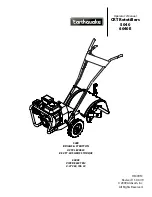
TM0497-2002
NACE International
11
8.5.4 Connect the voltmeter to the pipeline and
reference electrode as described in Paragraph 5.6.
8.5.5 Record the pipe-to-electrolyte potential and its
polarity with respect to the reference electrode.
8.6 Considering the Significance of Voltage Drops for Valid
Interpretation of the Criterion
8.6.1 The significance of voltage drops can be
considered by:
8.6.1.1 Comparing historical levels of cathodic
protection with physical evidence from the pipeline
to determine whether corrosion has occurred.
8.6.1.2 Comparing
soil
corrosiveness
with
physical evidence from the pipeline to determine
whether corrosion has occurred.
8.6.2 Physical evidence of corrosion is determined by
evaluating items such as:
(a)
Leak history data;
(b)
Buried pipeline inspection report data regarding
locations of coating failures, localized conditions of
more-corrosive electrolyte, or substandard cathodic
protection levels have been experienced; and/or
(c)
Verification of in-line inspection-tool metal loss
indications by follow-up excavation of anomalies and
inspection of the pipe external surface.
8.6.3 Cathodic protection shall be judged adequate at
the test site if:
(a)
The pipe-to-electrolyte potential measurement is
negative 850 mV, or more negative, with respect to a
CSE; and
(b)
The significance of voltage drops has been
considered by applying the principles described in
Paragraphs 8.6.1 or 8.6.2.
8.7 Monitoring
When the significance of a voltage drop has been
considered at the test site, the measured potentials may be
used for monitoring unless significant environmental,
structural, coating integrity, or cathodic protection system
parameters have changed.
________________________________________________________________________
Section 9: Test Method 2—Negative 850 mV Polarized Pipe-to-Electrolyte
Potential of Steel and Cast Iron Piping
9.1 Test Method 2 describes the most commonly used test
method to satisfy this criterion (see Paragraph 9.2). This
method uses current interruption to determine whether
cathodic protection is adequate at the test site according to
the criterion.
9.2 Scope
This method uses an interrupter(s) to eliminate the cathodic
protection system voltage drop from the pipe-to-electrolyte
potential measurement for comparison with the criterion
stated in NACE Standard RP0169,
1
Paragraph 6.2.2.1.2:
A negative polarized potential of at least 850 mV
relative to a saturated copper/copper sulfate reference
electrode (CSE).
9.3 General
9.3.1 Interrupting
the
known
cathodic
protection
current source(s) eliminates voltage drops associated
with
the
protective
currents
being
interrupted.
However, significant voltage drops may also occur
because of currents from other sources, as discussed
in Section 7.
9.3.2 To avoid significant depolarization of the pipe,
the “off” period should be limited to the time necessary
to make an accurate potential measurement. The “off”
period is typically less than 3 seconds.
9.3.3 The magnitude and duration of a voltage spike
caused by current interruption can vary, but the
duration is typically within 0.5 second. After the current
is interrupted, the time elapsed until the measurement
is recorded should be long enough to avoid errors
caused by voltage spiking. On-site measurements with
appropriate
instruments
may
be
necessary
to
determine the duration and magnitude of the spiking.
9.3.4 Current sources that can affect the accuracy of
this test method include the following:
(a)
Unknown,
inaccessible,
or
direct-connected
galvanic anodes;
(b)
Cathodic
protection
systems
on
associated
piping or foreign structures;
(c)
Electric railway systems;
(d)
HVDC electric power systems;
(e)
Telluric currents;
(f)
Galvanic, or bimetallic, cells;
(g)
DC mining equipment;
(h)
Parallel coated pipelines, electrically connected
and polarized to different potentials;
(i)
Uninterrupted current sources;
(j)
Unintentional connections to other structures or
bonds to mitigate interference; and
(k)
Long-line currents.
Содержание CP 1
Страница 1: ...CP 1 Cathodic Protection Tester Course Manual February 2005 NACE International 2000 ...
Страница 265: ......
Страница 266: ......
Страница 267: ......
Страница 268: ......
Страница 301: ...RP0169 2002 32 NACE International ISBN 1 57590 035 1 ...
Страница 535: ...TM0101 2001 24 NACE International ISBN 1 57590 137 4 ...
















































